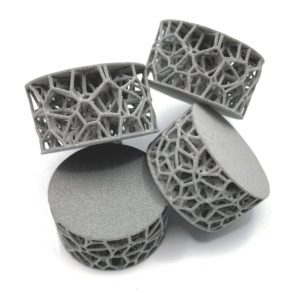Design is Boundless with Additive Manufacturing.
Unlike the one-size-fits-all approach of conventional manufacturing methods, additive manufacturing (AM) or 3D printing, provides numerous benefits to product development and production with the creation of complex parts with intricate geometries. These advantages are only expounded upon through the formation and use of lattice structures when designing for additive manufacturing (DfAM), resulting in improved structural optimization and functional design.

What Are Lattice Structures?
There are a numerous types of lattice structures with distinctive aesthetics and characteristics. Inspired by crystalline structures found in nature, engineered lattices are more than an ornamental feature. These type of lattices are networks of crosshatch sections consisting of cells, nodes and beams, which provide mechanical engineers the ability to construct reinforced and optimized structures. Due to their inherently small features, lattices are nearly impossible to fabricate with traditional manufacturing.
With 3D printing, mechanical engineers use lattice structures to create innovative and higher performing parts and products.
The Advantages of Using Lattices In Design for Additive Manufacturing
3D printed lattice structures provide many mechanical advantages. Weight reduction while retaining structural integrity is perhaps the most important benefit and the primary reason engineers use lattices to optimize 3D printed parts. Lattice structures enable engineers to increase overall surface area and distribute material in the most structurally effective way possible, allowing for the production of lightweight parts with optimized weight-to-strength ratios.
The customizable nature of lattices also provides the ability to refine designs to match application requirements, leading to increased control over shock absorption and impact resistance. By adjusting the thickness and position of lattice sections, engineers can reduce impact stress or employ elements that act as auxiliary features to protect critical parts of a product. Similarly, mechanical engineers can integrate characteristics to enhance vibration and noise dampening performance.
The ability to unlock a large amount of surface area with lattice structures also benefits heat dissipation. Because lattice structures feature hollowed crossed-sections, heat can be dissipated at higher rates and more uniformly. This efficiency gain can be realized for various heat exchanger applications, where small features with large surface areas are difficult or nearly unfeasible to produce without additive manufacturing.
Material selection also determines which lattice properties are possible. Choosing an elastomeric 3D printing material, like Lubrizol ESTANE® 3D TPU M95A, to manufacture parts with lattice structures can reduce weight without compromising flexibility and resistance. This attribute is incredibly valuable in the packaging and footwear industries. The use of a TPU lattice structure in a shoe midsole or outsole can increase airflow, energy return, and compression recovery. A lattice could, for instance, be used around or inside electronic components to protect it from a dynamic incident, such as as an all-too-common accidental drop.


Creating Lattice Structures
Driven by the ability of 3D printing to produce extremely complex geometry, product designers are increasingly being expected to incorporate optimization-based techniques to their designs. Although CAD software plays a great role in the development of lattice structures these models tend to be limited to base and perimeter geometries as well as boundary constraints. To overcome these restrictions, a dedicated lattice generation tool or generative design program can help make the most of new design possibilities to optimize parts.
Avid Product Development utilizes nTopology to design lattice structures. nTopology allows for complete control over every aspect of the geometry and adds additional value by incorporating topology optimization in the design of 3D printed parts with lattice structures.
Contact our 3D printing design team today to learn how design for additive manufacturing and lattice structures can benefit your business.
